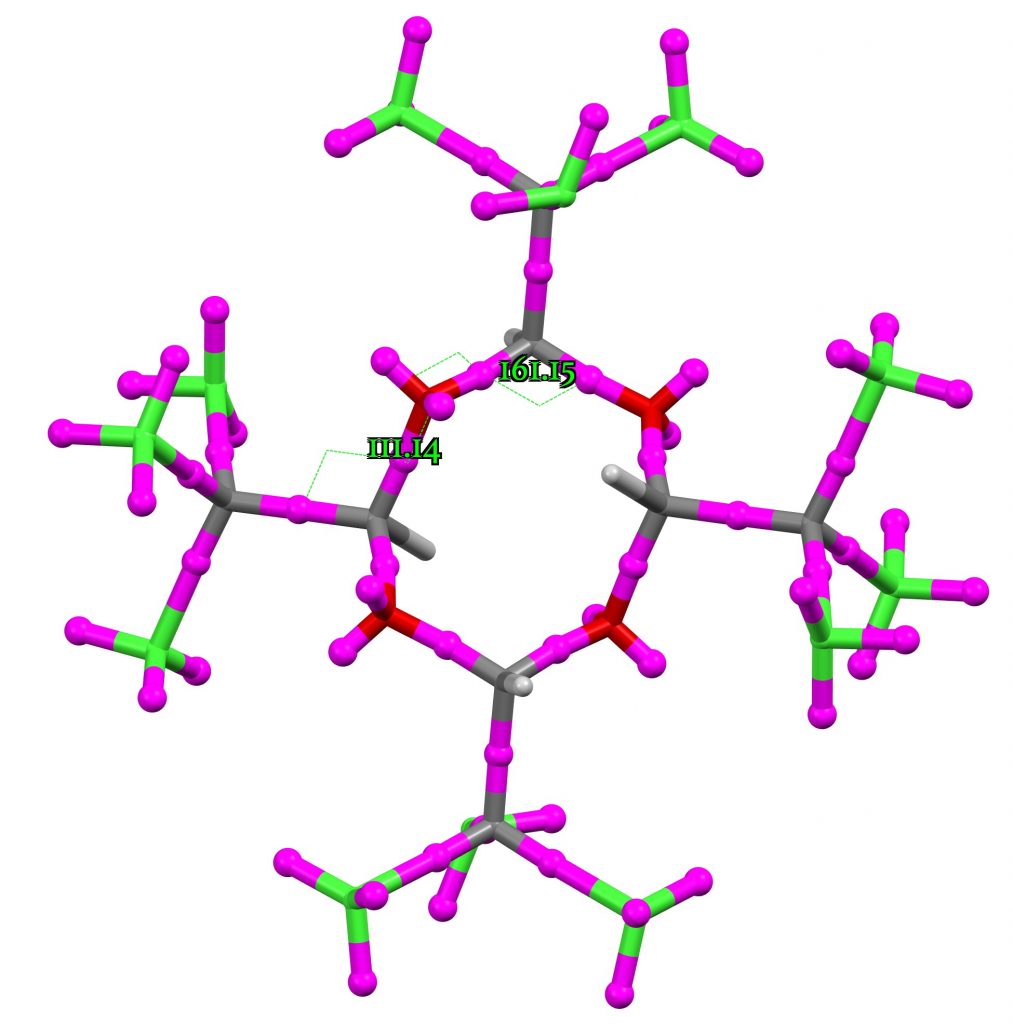Metaldehyde is an insecticide used to control slugs. When we unsuccessfully tried to get some recently, I discovered it is now deprecated in the UK. So my immediate reaction was to look up its structure to see if that cast any light (below, R=CH3, shown as one stereoisomer).
A X-ray crystal structure exists (DOI: 10.5517/ccdc.csd.cc20n2pg) and reveals it to be the tetramer of acetaldehyde, or (CH3CHO)4. One further structure came to light, another tetramer of trichloromethylacetaldehyde, known as chloral.[cite]10.1071/CH9802249[/cite] This latter compound forms a hydrate, hence chloral hydrate. These two compounds, differing only in the methyl group, show very different conformations of the eight-membered rings. As to why this is, makes for a fascinating story.

Click to obtain 3D model
Firstly, the approach I used. I optimised the structure from the crystal data using ωB97XD/Def2-TZVPP, using C4v symmetry in which all four of the methine hydrogens point in the same direction. The resulting four H…H contacts of 2.13Å are on the short side, and are certainly contributing to the stability by dispersion (London) attractions. The C-O distances are 1.399Å. I then did an ELF (Electron localisation function) analysis to identify what are called the monosynaptic basins. Better known as lone pairs! These (along with the disynaptic basins along the C-O bonds) are shown in purple above. I have displayed the torsion or dihedral angles between each of the lone pairs on oxygen and the adjacent C-O bond (150.1 and 42.0°). This now reveals the so-called anomeric effects in the molecule. Basically one of the lone pairs on oxygen has eight sets of 150.1 angles and the other lone pair eight sets of 42.0°. Only the former lone pairs are close to being anti-periplanar to the adjacent C-O bond. In this geometry, this lone pair can donate into the C-Oσ* orbital of the bond. One can quantify the strength of this interaction using NBO (natural bond orbital) analysis, which gives a so-called E(2) perturbation interaction energy of 19.7 kcal/mol, in total eight of them. The other lone pair on each oxygen shows no discernible interaction.
On to Chloral (X = CCl3). This shows an entirely different geometry with Ci symmetry. This has two distinctly different pairs of oxygen atoms, with a pair of 2.36Å H…H contacts and two pairs of C-O distances 1.406 and 1.378Å; 1.406 and 1.380Å. This asymmetry immediately implies chloral will be more reactive towards e.g. hydrolysis, since one of the C-O bonds is already slightly lengthened. There are 16 distinct dihedral values between an oxygen lone pair and either an adjacent C-O or a C-CCl3 bond. The largest has a torsion angle at C-O of 161.2° with an NBO E(2) energy of 20.6 kcal/mol for a C-O interaction; the other torsions are 149.9, 141.1, 127.5, 112.6, 112.0, 111.1, 74.6, 68.2, 54.1, 42.6, 38.7, 32.6, 20.7, 5.7 and 4.1. There is a new anomeric effect to the adjacent C-CCl3 bond of 12.1 kcal/mol, lower for this latter interaction because the angle (113°) is far from the ideal 180°. In this model, all eight oxygen lone pairs play a role in stabilising the molecule, whereas in metaldehyde only four lone pairs do this.

Click to obtain 3D model
One can now transpose the symmetry of each molecule onto the other compound. Metaldehyde in Ci symmetry is +5.5 kcal/mol higher in free energy and chloral in C4v symmetry is +3.9 kcal/mol. The origins of these difference are probably dissipated across the multiple anomeric effects and H…H dispersion attractions.
This technique of locating the centroids of lone pairs using ELF and then correlating the dihedral angle between the lone pair and any adjacent C-X bond (X = electronegative, which makes the C-X bond a good electron acceptor) is very useful in explaining instances of the anomeric effect and comparing them across isomers.
Metaldehyde was known to me as solid fuel for toy steam engines, or for survival/military stoves. They were sold in small bricks of essentially pure compound for such purposes. The compound is toxic for small mammals (also children) and quite a few intoxications have been documented. The rumor went that you could intoxicate your unloved neighbor’s dog (alternatively: your neighbor’s unloved dog) by offering him a meta brick hidden inside a sausage. Not that I would support any such cruelties, but it was a well-known rumor in pre-internet times.
The toxic effects of metaldehyde are not due to acetaldehyde (hydrolysis product), but apparently unique to the substance.
Nowadays solid fuel is mostly hexamethylenetetramine (urotropin) which is less toxic.
Interestingly metaldehyde is formed from acetaldehydy by acid-catalyzed oligomerization at -20 °C or so, whereas at r.t., paraldehyde is formed. An interesting case of kinetic vs. thermodynamic control?
Also interesting: chloraldehyde forms a helical, chiral polymer upon storage, in preference over cyclic oligomers.
All fascinating. Thanks Lukas!
re: “Also interesting: chloraldehyde forms a helical, chiral polymer upon storage, in preference over cyclic oligomers.”
I wonder, if chloral is stored in the presence of small amounts of a chiral molecule, would it form pure left or right handed helices? And if the configuration of the chiral additive is inverted, would it form the opposite handed helix? (DOI: 10.1021/ja00016a076 or 10.1016/B978-0-444-53349-4.00175-8″).
Henry, yes, the author O. Vogl you cite in the first reference has worked a lot on this. I cursorily looked over the literature of induced helical polymers a few years back. A key early paper on the induced asymmetriy of the chloral polymer (itself known since the 19th century) could be http://dx.doi.org/10.1007/bf00291959 a key late paper https://doi.org/10.1295/polymj.23.1213
There is also an account of this work at https://doi.org/10.1021/ar00021a005
Vogl was using chiral alkoxide and got optically active polymer of either sense of optical rotation (+4000, –4000 specific rotations), but the materials were quite insoluble and difficult to study.
My question at the time was if a chiral helical polymer could explain the high induction in the Soai asymmetric autocatalysis reaction. However, the X-rays now available of the reaction product (zinc alkoxide form) do not show helical structures.